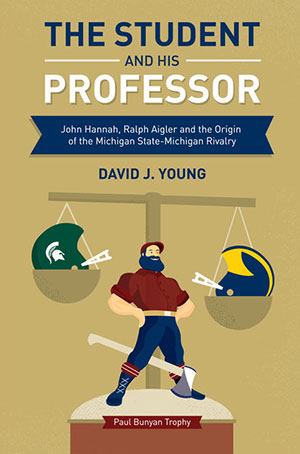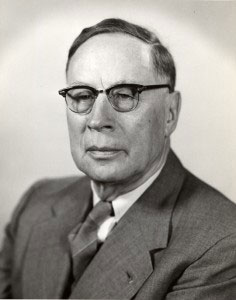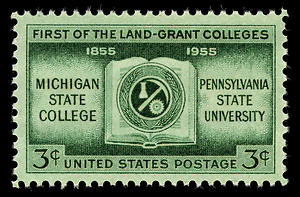A school by any other name…
In January 1954, John Alfred Hannah, the savviest educator in Michigan, made a move long hoped for in East Lansing.
The school that Hannah had been building into an academic and athletic powerhouse had been a university in fact since at least 1930, he declared. It was time to recognize reality by changing a single word in its name.
It had been founded in 1855 as the Agricultural College of the State of Michigan, the first of its kind in the U.S. and the prototype for the vast program of public schools launched by the Morrill Land-Grant College Act in the administration of Abraham Lincoln.
The name was changed to State Agricultural College in 1861, then to Michigan Agricultural College in 1909, then, in 1925, to a name reflecting its expansion from its original focus on farming — Michigan State College of Agriculture and Applied Sciences.
Built on the land-grant vision of practical training for practical work, Michigan State — as it was universally known by the 1950s — now comprised nine colleges and a panoply of distinguished graduate programs. Since World War II, Hannah’s massive construction program had bulked up the campus, with a student body rising by the thousands.
So he proposed to the governor and legislature that his school should be awarded its place in the first rank of American higher education with a new name: Michigan State University.
In Ann Arbor, the response was: Not so fast.
Just three words
 The collision between Hannah’s ambition and U-M’s pride are detailed in a new book by an East Lansing native, David J. Young, a Notre Dame alumnus who scoured Big Ten archives to write The Student and His Professor: John Hannah, Ralph Aigler, and the Origin of the Michigan State-Michigan Rivalry.
The collision between Hannah’s ambition and U-M’s pride are detailed in a new book by an East Lansing native, David J. Young, a Notre Dame alumnus who scoured Big Ten archives to write The Student and His Professor: John Hannah, Ralph Aigler, and the Origin of the Michigan State-Michigan Rivalry.
Young shows how U-M’s governing regents directed President Harlan Hatcher to wage a campaign against the name change. Prominent alumni were alerted, as were U-M’s allies in the state legislature. Professors in the Law School were enlisted to draft legal arguments, including Ralph Aigler, who had spotted Hannah’s talents years earlier, when he was briefly a law student at U-M.
“It is the duty of this board to protect the name of the University of Michigan as such,” declared Regent Roscoe Bonisteel of Ann Arbor, “because I believe every graduate of this institution has a vested interest in the name ‘University of Michigan.’”
“College” or “university” — what difference did it make?
In the U.S., traditionally, a university trains both undergraduate and graduate students in many fields, while a college offers only the undergraduate bachelor’s degree. A college is either a free-standing entity (Kalamazoo College, for example) or one arm of a multi-unit university, such as U-M’s College of Literature, Science and the Arts. (There are also “schools,” a term generally given to post-graduate professional programs, i.e., the Law School, the Medical School.)
By that standard, even Ann Arbor granted that Michigan State had been a university for years. It wasn’t the definition that caused brows to wrinkle in Ann Arbor. It was just that particular combination of three words: “Michigan State University.”
If that name came into being, wouldn’t the rest of the world be thrown into doubt about U-M’s standing as theUniversity of Michigan — not exactly the one and only, since, sure, that was technically a university up in East Lansing, but … you know …“the leaders and best”?
A name like “Purdue”
Hatcher and the U-M Regents suggested Michigan State follow the example of Purdue — a fine land-grant institution with “university” in its name, but with nothing that interfered with the name of Indiana University in Bloomington.
The name change would cause “endless confusion,” argued U-M’s advocates, and it would even be unconstitutional since the state’s constitution spoke of a state university in the singular.
Aigler, who had fought State’s admission into the Big Ten, said he already had met people who couldn’t tell the difference between the two schools. It happened at the 1954 Rose Bowl, where State, making its first appearance in Pasadena, showed its muscle by beating UCLA, 28-20.
“When I was in Los Angeles over the New Year’s,” he wrote in a private letter, “it interested me to find out how many people thought that the football team playing there … represented the University of Michigan. With the proposed change in name effective, the confusion (and in matters more important than football) would be much more pronounced.”
In the face of Ann Arbor’s stiff response, President Hannah beat a strategic retreat, then marshaled his forces for a second try in 1955, when Michigan State would celebrate its 100th anniversary.
Who’s arrogant?
In the first skirmish over the name in 1954, students at State had been indifferent. But in 1955 — probably with behind-the-scenes encouragement from Hannah — they got into the act, delivering 11,000 signatures to state legislators on a petition 250 feet long.
In Ann Arbor, The Michigan Daily took State’s side.
“At the proud University of Pennsylvania they may be snickering a little,” the editors wrote. “No one yelled when Penn State College switched to Penn State University.”
Meanwhile, U-M alumni showed how their school’s reputation for arrogance had arisen.
“Traditionally and historically Michigan State College has none of the aspects of a university,” a 1950 grad advised Governor G. Mennen Williams. “The mediocre scholastic caliber of Michigan State College is well known throughout the midwest. This school should be concentrating on ways and means of raising its scholastic standards, rather than changing names.”
With tongue apparently in cheek, an Ypsilantian wrote Hatcher to suggest that the name “Wolverine State University” might “satisfy the desire of M.S.C. for university status.”
An anonymous reader of The Detroit Newsnoted State’s history of name changes and said: “Give them one or two winning football teams and they’ll want to change the name again, to ‘University of America.’”
Across the state, Michigan State loyalists detected an unseemly selfishness in Michigan’s dogged defense of its status.
“I am beginning to feel that the ‘confusion’ argument is but a bit of subterfuge,” a State alumnus wrote Hatcher. “I strongly believe that you, as a gentleman and an educator, must feel, deep down in your heart, that the University of Michigan is acting in a manner far removed from the dignified and altruistic nature one comes to expect from an institution as excellent as the University of Michigan.”
A new name
As Hannah renewed his push for the change in 1955, factors were trending in his favor, not least his own good reputation.
While remaining in charge of Michigan State, Hannah was now splitting his time between East Lansing and Washington, D.C., where he was spending his weekdays as assistant U.S. Secretary of Defense for manpower under President Dwight D. Eisenhower — a patriotic feather in East Lansing’s cap.
And the down-to-earth Hannah had always been more popular with legislators than the chilly Hatcher. It didn’t escape their notice that Hannah drove himself over to the state Capitol in his own pick-up truck, while Hatcher arrived in a chauffeur-driven sedan.
In the state House, U-M went down to a crushing defeat. The vote was 88-14 in favor of the name change.
A tighter vote was expected in the Senate.
Then the state’s attorney general, Thomas Kavanaugh, declared that he saw no constitutional problem with changing State’s name.
Quit while you’re ahead
U-M geared up to sue. But E. Blythe Stason, dean of the Law School, now advised Hatcher to put down the sword. U-M might well win in court, Stason said. But that would only trigger a campaign for a constitutional amendment, and then the voters would have a chance to show which school was more popular.
“In short,” Stason told Hatcher, “we are confronted with the situation where we may win the battle but lose the war.”
In the Senate, the tally was even higher in Hannah’s favor—23 votes for “MSU,” only two against. Lieutenant Governor Phil Hart, a U-M law grad and later one of Michigan’s great U.S. senators, signed the bill into law with Hannah looking on.
Much later, Hannah gave his view of U-M’s role in the fight with a twinkle in his eye.
“Interestingly enough,” he remarked, “the University of Michigan’s persistent opposition and its administration’s political tactics in the legislature made it easier for us …”
In the end, the name change simply ratified something that had already happened. As Hannah put it, “We intended to make Michigan State a distinguished university, worthy of the name. I think we did so, long before its name was officially changed by the state legislature.”
Anybody confused about which university is which?
Sources included the papers of Harlan Hatcher at the Bentley Historical Library; David A. Thomas, Michigan State College: John Hannah and the Creation of a World University, 1926-1969 (2008); John Hannah, A Memoir (1980); and David J. Young,The Student and His Professor: John Hannah, Ralph Aigler and the Origin of the Michigan State-Michigan Rivalry (2015). Young’s title refers to the relationship between the key antagonists of his story. As a young man, Hannah had been Aigler’s student in the Michigan Law School. Hannah stayed only one year, but Aigler predicted a great future for him. The book is available at www.msu-umbig10.com.








William Pervin - 1952, 1952
Years ago, when I was teaching at the Penn State U, at least once a year we would receive a call from a prospective speaker just before the time of his or her lecture saying: “I’m here, where are you?” Of course the speaker had gone to the U of Penn in Philadelphia not Penn State U in State College.
Reply
Paul LeValley - 1964
People at the University of Michigan had long referred to agriculturally based Michigan State as “the cow college.” After the name upgrade, a few jokingly called it “the udder university.”
Reply
tone smith - 2009
This piece seems a little harsh against Michigan to be arriving in my alumni newsletter.
Reply
James Tobin - 1974, 1978, 1986
Speaking just for myself — and I’m the middle member of three generations of proud U-M alums — I think we do more for Michigan by considering its history honestly, and with a little humility, than by pretending it’s never done anything wrong.
Reply
David Burhenn - 1975, 1982
I fully agree with Jim Tobin. John Hannah (a fellow Grand Rapids native who started his college career in Ann Arbor before transferring to MAC) was clearly in the right here, and Michigan’s regents and administrators did themselves and the university no favors. Frankly, the whole MSU incident (and the resistance to Michigan State joining the Big 10) is am embarrassing chapter in our history. Interesting that at the time, Michigan was led by a president whose academic career and reputation was made at . . . . Ohio State.
Reply
Anne McLaughlin - 1984
Aren’t “academic career” and “Ohio State” mutually exclusive? Oops, my Michigan arrogance showing again. 😉
Reply
James Mercier - 2003, 2006
I don’t think there was anything wrong with our opposition to MSU’s candidacy for Big Ten membership. It was logical that we did not consider it in our best interests, from an athletic standpoint, to have an in-state competitor. Ohio State has always opposed a second Big Ten school from Ohio for the same reason, and Penn State was not in favor of Pittsburgh joining, either.
Reply
Peter Eckstein - 1958
Another fine story by Jim Tobin. I was a member of the staff of The Michigan Daily during the second phase of Hannah’s campaign to change the name, and we were all a bit dumbfounded by Hatcher et al in their stubbornness in refusing to accept reality. In the 6 decades since I have read no stories of high school graduates applying to the wrong university or football fans rooting for the wrong team due to
Some confusion between Michigan and Michigan State.
Reply
H Stephen Straight - 1965
My parents were graduate students at U-M in 1943 when I was born, and both were employed by “the U” after they received their masters degrees. My sister and I both got our bachelors degrees from LSA, “the lit. school”. I and my wife, who also earned a BA from Michigan, met in Ann Arbor. My son was a second-generation quadruple-legacy U-M admit. I sang with the U-M Mens Glee Club for all four years, and know very well what it means to “… Wanna Go Back to Mich-igan”. All that said, as a lifelong Wolverine who went on to pursue an academic career, I have long since recognized MSU as the equal of U-M in many fields and even superior to it in a few. Amazingly, I have no recollection of the MSC > MSU naming struggle. I have never referred to MSU as “Cow College”, preferring instead “Moo U”. (Sorry, I couldn’t resist.)
Reply
D Foster - 2007
Can I get a siren?
Reply
Marc Schiller - 1974
How about a cowbell?
Reply
Barbara Mccall Fountain-Sinks - U High MIchigan
Was your Dad English Professer @ UH in 1940 or later
Reply
Shone Brooks - 1996
While attending the 1994 Hall of Fame Bowl in Tampa, Florida with the Michigan Marching Band, one sports announcer introduced the UM football team as the “Michigan State Wolverines!”
Reply
Josh Skarf - 2004
I live far away from the Midwest and I get asked all the time if University of MIchigan is the same thing as Michigan State University. Or alternatively, sometimes people just assume they are the same place. I’d say that especially internationally, people have trouble distinguishing the two.
Reply
Jane Namenye - 1980
This comment reminded me of the Gerald Ford presidential visit to China during which he was treated to a performance of the MSU fight song, instead of The Victors. I didn’t recall the details, but I found them in a note from the Michigan Daily: https://www.michigandaily.com/content/week-daily-history-3 and an original article from the Pittsburg Press https://news.google.com/newspapers?nid=1144&dat=19751201&id=d78cAAAAIBAJ&sjid=BFcEAAAAIBAJ&pg=3058,19231&safe=vss&hl=en
Reply
Gerald F Rosenblatt - 1961 Law
Now I know why Dean Stason and President Hatcher were rarely seen or heard from while I was at the Law School. Too busy dealing with this urgent matter.
Reply
Robert SMith - 1976
i would love to have the shirt
Graduated from both schools and it would be fiiting
Reply
Matt Orth - 1989
Speaking from the perspective of undergrad at State in ’80 & grad school at UM in ’89, I think that the state of Michigan is big enough for both. Agree with Robert Smith, great shirt!
Reply
David Eldred - Physics 1984
While backpacking in Czeckoslovakia in August of 1983 (probably wearing my “Michigan” t-shirt), I saw a guy wearing a blue college sweatshirt. The school crest was the US defense department eagle with arrows and the name was “MICHIGAN UNIVERSITY”. Obviously an east-block knockoff. With three U of M siblings, a grandfather on the ’28 MAC basketball team and an extended family split between the schools, I always look back and regret not offering the guy $10 for it.
Reply
Jim Keen - 1989, 2011
Interestingly, when traveling outside of the state, I’ve noticed the following conversation when someone asks where I went to school:
“Where did you go to school?” they ask.
“Michigan,” I say.
“Michigan State?”
“No. The University of Michigan.”
I’ve always thought it strange that I need to clarify.
Reply
Mike Wirt - 1971
As a 1969 MSU graduate I was well aware of the MSU-UM rivalry, which seemed to be arrogance on UM’s part more than anything else. It was the “Moo U” era. That said, I attended grad school in Ann Arbor and felt no animus toward me as am alumnus of an inferior college. I’m proud to be a graduate of both.
Reply
Mary Ellen Vaydik - 1964
Traveling in the Berkshires in Massachusetts last fall, I was trying to find a sports bar that would televise the UM football game. I was told, “Sure, c’mon over!” only to arrive and discover the MSU game being broadcast. The innocent bartender said,”Aren’t they the same thing?” To his credit, after my explanation, he did attempt to find the correct game, but his TV supplier didn’t include BTN.
Reply
Saul Wexler - 1964 U.of Wisconsin
Great historical piece very much appreciated by this neutral non-combatant.
Reply